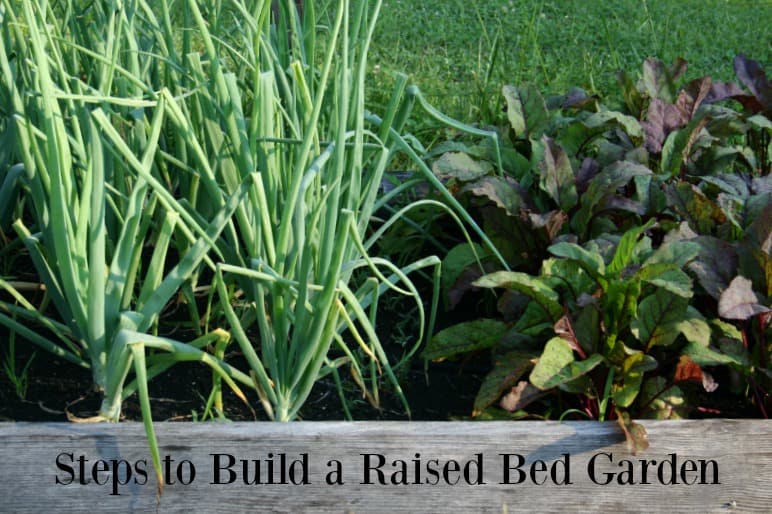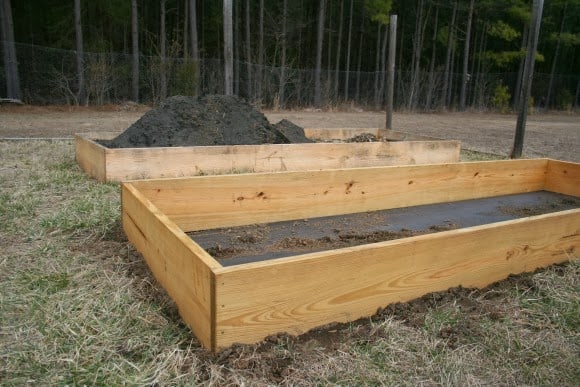
Steps to Build a Raised Bed Garden
In the afternoon on both Saturday and Sunday, I helped Hubby rebuild and replace the raised bed in the vegetable garden that collapsed over the winter. You may recall from my previous posts on raised bed vegetable gardening that our garden contains three beds built from untreated lumber, and the remaining beds built from pressure-treated lumber. The untreated lumber lasts approximately five to six years. The bed below is five years old and you can see that rot has set in as well as insect damage. The corners tend to go first, as well as the eastern ends for some reason.
- Three boards of untreated lumber 8 feet long x 12 inches high x 2 inches wide (8′ x 12″ x 2″)
- Drill
- 4″ or 6″ screws, four for each corner, 16 screws total
- Protective paint and paintbrush
- Saw
- Saw horses
- Landscape fabric
- Hammer
- Heavy duty wood staples
- Scissors
- Tape measure
- Pencil
How to Build a Raised Bed for a Vegetable Garden
- Measure the wood to cut one board in half so you have two pieces exactly 4 feet long. Place board on saw horse and with a helper, measure, mark with a pencil, and saw in half.
- Place boards on the saw horse and paint each side, including ends, with the protective paint. We used a wood sealant with a bit of tint to it, but you can use clear. We’ve found that the paint adds a year or more of life to the wood by placing one added barrier between untreated lumber and the elements.
- Allow the paint to dry thoroughly. Drying time will depend on the weather conditions, but on a dry, breezy day it takes about an hour or two.
- Move the lumber into position in the garden. You will build the bed upside-down and then flip it into position, so you need at least two people. Place the “bad” or ugly side of the wood, if any, facing up. When you flip the garden bed frame, the ‘bad’ side will then face down.
- With a helper, hold the short board inside the long board, making a 90″ degree angle in the corner. Using the drill, drill two holes, top and bottom, about 1″ from the edge, into the wood to affix the sides. Then drill two more holes and screw in the screws. Do the same with the other long board, making sure it is as even as possible with the other piece of wood. When three sides are attached, attached the other short side.
- With your helper, stretch the roll of landscape fabric out so you run it over the length of the frame. Use the staples and the hammer to tack it onto the side of the frame, making it tight like the skin of a drum. You will need to run two lengths of fabric. Trim the edges and nail it neatly to the bottom.
- With your helper, carefully pick up the frame and turn it over. It will be HEAVY so you may need more people. Don’t hurt yourself! Once it is in position, you may need to shift it into the right spot. We needed to even out the ground underneath to remove stones; you may need to do the same thing to get the bed to stay as level as possible. If it’s not level, it will be okay, but it will put extra stress onto the corners and wood of the raised garden bed frame.
- Once the raised vegetable garden bed is in position, you now have a bed with bottom (made of landscape fabric over the ground) and four sides 12″ high. Fill with your choice of soil and amendments to a depth of 10″, leaving about 2″ of room from the top of the garden bed to the soil level. The soil may settle after the first watering or two, so add more if the level drops.








This is FABULOUS! I have been wanting to do exactly this for a while now! Thank you for the great tutorial! I’m pinning for later 😀